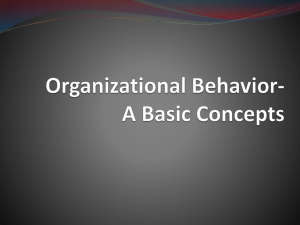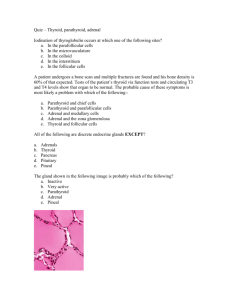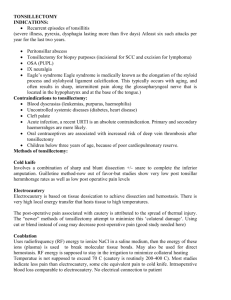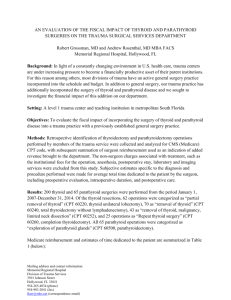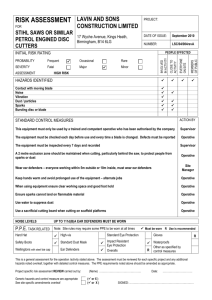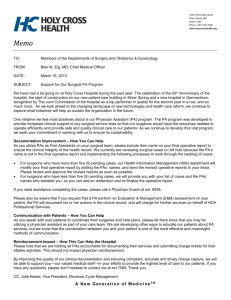GI Endoscopic Procedures Operative Sequence
advertisement
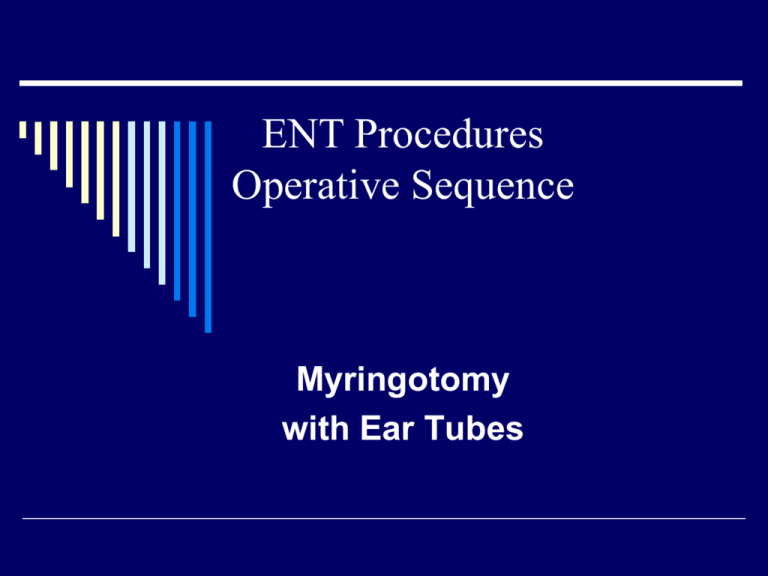
ENT Procedures Operative Sequence Myringotomy with Ear Tubes Myringotomy Define the procedure: A small incision is made in the tympanic membrane to allow the drainage of fluid from the middle ear and the placement of ear tubes. Myringotomy Overall Purpose of Procedure: Relieve effusion. Effusion = ‘s fluid in the middle ear causing painful ear infections (a.k.a. acute otitis media) Acute otitis media - Inflammation of the middle ear in which there is fluid in the middle ear accompanied by signs or symptoms of ear infection: a bulging eardrum usually accompanied by pain; or a perforated eardrum, often with drainage of purulent material (pus). Ear Tubes Ear tubes are tiny cylinders placed through the ear drum (tympanic membrane) to allow air into the middle ear. They also may be called tympanostomy tubes, myringotomy tubes, ventilation tubes, or PE (pressure equalization) tubes. These tubes can be made out of plastic, metal, or Teflon and may have a coating intended to reduce the possibility of infection. There are two basic types of ear tubes: shortterm and long-term. Ear Tubes cont. Short-term tubes are smaller and typically stay in place for six months to a year before falling out on their own. Long-term tubes are larger and have flanges that secure them in place for a longer period of time. Long term tubes may fall out on their own, but removal by an ENT surgeon is often necessary. Myringotomy Wound Classification: 2 Operative Sequence 1- Incision 2- Hemostasis 3- Dissection 4- Exposure 5- Procedure (Specimen Collection possible) 6- Hemostasis 7- Irrigation 8- Closure 9- Dressing Application Myringotomy Instrumentation: Myringotomy tray, microscope, speculum holder, micro-instruments. Positioning: The patient is in supine position arms tucked. MD will sit for procedure. Prepping: Surgeon preference. Hibiclense or a Betadine Prep Kit. Betadine can be placed on cotton ball to swab the ear if MD prefers. Some use no prep at all...always ask Draping: 4 towels and a head drape. Ask about towel clips. Ask about clear incise drape. Myringotomy Begin your Operative Sequence Incision: made into the tympanic membrane with myringotomy blade (this step is out of order in this surgery due to the fact that we already have an opening to work through – the ear canal) Myringotomy cont. Operative Sequence Hemostasis: none Dissection and Exposure: ear spec and microscope Exploration and Isolation: MD will remove ear wax (cerumen) with ear curettes and visualize the TM. Myringotomy cont. Operative Sequence Surgical Repair/Removal/Specim en Collection: Will make a 2mm to 3mm incision into the TM. Fluid is suctioned out with micro-Frasier suction, #3 or #5. Myringotomy cont. Operative Sequence Surgical Repair/Removal/Spec imen Collection: PE tube is grasped either by the MD or scrub with alligator forceps. Placed into the incision. Rosen needle (actually a pick) used to manipulate PE tube into correct position. Video http://www.youtube.co m/watch?v=j_Z-ylTtRts Myringotomy cont. Operative Sequence Hemostasis and Irrigation: none Closure: Places antibiotic drops into ear canal. Places cotton ball in ear canal. Myringotomy Major Arteries: Posterior auricular artery Labyrinthine artery Major Veins: Posterior auricular vein Myringotomy Major Nerves: Vestibular nerve: The vestibular nerve is one of the two branches of the Vestibulocochlear nerve (the cochlear nerve being the other). It goes to the semicircular canals via the vestibular ganglion. It receives positional information. ENT Procedures Operative Sequence Tonsillectomy & Adenoidectomy Tonsillectomy and Adenoidectomy Tonsils are small, round pieces of tissue that are located in the back of the mouth on the side of the throat. Tonsils are thought to help fight infections by producing antibodies. Adenoid - Lymph-like areas of tissue, or glands, that are similar to the tonsils, but they are located very high in the throat, behind the nose. They trap and filter out germs that enter the body. The adenoids also help your body fight off infection by making antibodies. Types of Tonsils Palatine tonsils--located on each side of the throat. Pharyngeal tonsils--also known as adenoids are near the posterior openings of the nasal cavity. Lingual tonsils--near the base of the tongue You have your adenoids when you are born and they continue to grow until you are 5 to 7 years old. By school age, the adenoids begin to shrink in size, and, by the time children reach their pre-teen or teenage years, the adenoids are usually small enough to not cause any symptoms. What Are the Symptoms of Enlarged Adenoids A child may complain of: difficulty breathing through the nose is breathing through the mouth talks as if his or her nostrils are pinched breathes noisily snores while sleeping stops breathing for a few seconds while sleeping (called sleep apnea) Tonsillectomy and Adenoidectomy Define the procedure: removal of tissue to eradicate infection, improve the airway or remove cancer. Tonsillectomy and Adenoidectomy Overall Purpose of Procedure: 3 pathological indications for removal of the tonsils and adnoids: Infection Hypertrophy- enlargement via cellular growth Cancer Pt. may suffer from tonsillitis, peritonsillar abscess, strep throat, irr. sleep patterns, difficulty swallowing. Adenoids can become hypertrophic to the point of blocking the Eustachian tube, causing otitis media. Tonsillectomy and Adenoidectomy Wound Classification: 2 Operative Sequence 1- Incision 2- Hemostasis 3- Dissection 4- Exposure 5- Procedure (Specimen Collection possible) 6- Hemostasis 7- Irrigation 8- Closure 9- Dressing Application Tonsillectomy and Adenoidectomy Instrumentation: T&A tray Positioning: The patient is in supine position arms tucked. MD will sit for procedure. Spin bed 90 degrees for some Md’s. Prepping: NONE! Draping: 4 towels and a head drape (depends on MD). Ask about towel clips. Down sheet. Tonsillectomy and Adenoidectomy Begin your Operative Sequence Incision: This step comes later in the procedure. Hemostasis: none at this point in the procedure. Tonsillectomy and Adenoidectomy cont. Operative Sequence Dissection and Exposure: Mouth Gag of Md choice is placed into pt’s mouth. Mouth gag WILL REST on mayo stand. Tonsillectomy and Adenoidectomy cont. Operative Sequence Exploration and Isolation: MD might have headlight for visualization purposes. Tonsil is grasped with Allis clamp, possible Allis Adair. Have FRED on mayo for dental mirror. Tonsillectomy and Adenoidectomy cont. Operative Sequence Surgical Repair/Removal/Specim en Collection: An incision is made in the grasped tonsil. Incision can be made with a Snare, Laser, Curette, or Coblation Wand. Tonsil is removed with the device of choice. Scrub needs to have a chromic suture ready on the table for heavy bleeding. Tonsillectomy and Adenoidectomy cont. Operative Sequence Surgical Repair/Removal/Speci men Collection: Coblation wand uses radiofrequency waves, instead of cautery (heat) techniques, to remove tonsils and adenoids. Coblation Tonsillectomy: http://www.youtube.com/wat ch?v=KizSZuqkyBc Tonsillectomy and Adenoidectomy cont. Operative Sequence Surgical Repair/Removal/Specimen Collection: You will repeat the same process for the other tonsil. Adenoid – MD will retract the palate with a red rubber catheter inserted transnasally. Clamp end of red rubber with Kelly. MD will use dental mirror to view adenoid tissue. Removal with same procedure as Tonsils. You will have specimens – ask then pass off. May need sterile safety pin to mark specimen. (usually the safety pin will go into the right tonsil. Be sure not to put the pin into your hand – Tonsils are very dirty) Tonsillectomy and Adenoidectomy cont. Operative Sequence Hemostasis and Irrigation: Heavy bleeding is a possibility. Always have NACL ready on back table or mayo. Closure: packed with strung gauze. May be soaked in viscous Lidocaine. T and A vid Child and Adult T&A EESEDU NEVER BREAK YOUR TABLE DOWN Tonsillectomy and Adenoidectomy Major Arteries: tonsillar and ascending palatine branches of the facial artery Major Veins: tonsillar veins Tonsillectomy and Adenoidectomy Major Nerves: tonsillar branches of glossopharyngeal nerve SUR 122 Tracheotomy/Tracheostomy Tracheostomy is indicated for a patient who requires emergent or elective airway management for: prolonged ventilator dependence acute upper airway obstruction chronic upper airway obstruction Pathology for Tracheotomy or Tracheostomy Vocal cord paralysis Neck surgery Trauma Prolonged intubation Secretion management Cannot intubate Stridor due to tracheal blockage Sleep apnea Anatomy of the Neck (From Potter PA and Perry AG: Fundamentals of nursing, ed 5, St Louis, 2001, Mosby.) Anatomy of the Larynx Anterior view of the pharynx Posterior view of the pharynx (From Thibodeau GA and Patton KT: Anthony's textbook of anatomy and physiology, ed 17, St Louis, 2003, Mosby.) Tracheotomy/Tracheosto my Tracheotomy temporary opening into the trachea to facilitate breathing Tracheostomy permanent opening of the trachea and creation of a tracheal stoma Must place tracheal tube with either Patient will be hooked up to a ventilator Long term tracheostomy may eventually be able to wean off ventilator, but maintain stoma that will function as their nose did prior to surgery Anesthesia General Local Medications Local anesthetic: Lidocaine or bupivicaine with or without epinephrine Antibiotic irrigation Positioning Supine Shoulder roll Donut headrest Pillow under knees Safety strap Prep End of chin to midchest and bedsheet to bedsheet Prep of choice: Duraprep, betadine scrub and/or paint Draping Towels Small fenestrated sheet (Pediatric lap sheet) Supplies, Equipment, Instruments Minor basin Basic pack Pediatric lap sheet Other small fenestrated sheet Blades Suture or ties of surgeon’s choice (prn) Tracheotomy tray Tracheotomy tube (Shiley) Twill tape Operative Sequence Discussion Surgical Procedures Tracheotomy/Tracheostomy Isthmus of thyroid is divided to expose the trachea Two tracheal rings are cut, and the upper ring is partially resected. Tracheal hook pulls the trachea from the depth of the wound toward the surface Tube is inserted (Modified from DeWeese DD: Textbook of otolaryngology, ed 6, St Louis, 1982, Mosby.) Considerations Will make sure obturator goes with patient to PACU or ICU Complications: hemorrhage, infection, damage to other structures TRACHEOSTOMY Video ENT Procedures Operative Sequence Septoplasty Septum anatomy The nasal septum separates the left and right nasal airway. The yellow portion is made of flexible cartilage, the quadrangular cartilage. The blue portion is thin bone, the perpendicular plate of the ethmoid bone. The purple portion is thicker bone, the vomer bone. Septoplasty Overall Purpose of Procedure: – To produce a patent nasal airway Septoplasty Define the procedure: – A surgical procedure done to improve the flow of air to your nose by repairing malformed cartilage and/or the bony portion. Indications 1. Mouth breathing, 2· Snoring, 3· Drooling during sleep, 4· Change in voice, 5· Decrease sense of smell and taste 6· Sometimes sleep disturbances. 7· The symptoms are usually worse on one side, and sometimes occur on the side opposite the bend. In some cases the crooked septum can interfere with the drainage of the sinuses, resulting in repeated sinus infections. The septum may also need to be straightened in individuals undergoing sinus surgery just so that the instruments needed for this operation can be fit into the nasal cavity. Septoplasty This procedure may be performed in conjunction with: – Rhinoplasty –a facial cosmetic procedure, usually performed to enhance the appearance of the nose. During rhinoplasty, the nasal cartilages and bones are modified, or tissue is added. The aim is to improve the visual appeal of the nose. Rhinoplasty is also frequently performed to repair nasal fractures. When rhinoplasty is used to repair nasal fractures, the goal is to restore pre-injury appearance of the nose. – Sinus surgery Septoplasty Septoplasty is rarely performed in children because the septum is is the major growth center of the midface; disrupting it may lead to maxillary hyperplasia (enlarged upper jaw) Wound Classification: 2 Operative Sequence 1- Incision 2- Hemostasis 3- Dissection 4- Exposure 5- Procedure (Specimen Collection possible) 6- Hemostasis 7- Irrigation 8- Closure 9- Dressing Application Septoplasty Instrumentation: Septoplasty tray Positioning: The patient is in supine position arms tucked. MD will sit for procedure. Spin bed 90 degrees for some MD’s. Prepping: NONE! Draping: 4 towels and a head drape (depends on MD). Ask about towel clips. Down sheet. Septoplasty Begin your Operative Sequence Incision: before this step comes the MD will inject the nose and turbinates with 1% Lidocaine with Epi. Then MD will pack the nose nasal packing soaked in vasoconstrictor of choice. (Afrin, Cocaine, Adrenaline) Hemostasis: epi Septoplasty cont. Operative Sequence Dissection and Exposure: – Placement of nasal speculum Septoplasty cont. Operative Sequence Exploration and Isolation: –MD might have headlight for visualization purposes. –May perform with the aid of a scope Septoplasty cont. Operative Sequence Surgical Repair/Removal/Sp ecimen Collection: – Incision is made into the septum below the obstruction. – Small Tenotomy scissors are used to dissect the membranous nasal septum and expose the cartilage. Septoplasty cont. Operative Sequence Surgical Repair: – A Freer or Cottle elevator is then used to elevate the septum off the underlying tissue. – MD removes the deviated bone using a small chisel and mallet. – Pieces are then removed with a Takahashi forcep – Incision repair with 4-0 Chromic suture Septoplasty cont. Operative Sequence Hemostasis and Irrigation: – NACL – Suction-Bovie if needed. Closure: internal nasal splints are placed bilat. to stabilize the septum and are stitched to the membranous septum with a 3-0 Chromic. Video: http://www.youtube.com/watch?v=2x72U THVKEI NEVER BREAK YOUR TABLE DOWN Septoplasty Major Arteries: – Facial Artery (exterior of nose) – branches from the internal carotid, namely the branches of the anterior and posterior ethmoid arteries from the ophthalmic artery, and (2) branches from the external carotid, namely the sphenopalatine, greater palatine, superior labial, and angular arteries. Major Veins: essentially follow the arterial pattern Septoplasty Major Nerves: – sensation of the nose is derived from the first 2 branches of the trigeminal nerve. ENT Procedures Operative Sequence Thyroidectomy Thyroid Functions • • • The thyroid gland functions in maintaining the body’s metabolic rate. One of the main functions is iodine metabolism. Thyroid - A gland located beneath the voice box (larynx) that produces thyroid hormone. The thyroid has 2 lobes and an isthmus. Isthmus – lies over the upper portion of the trachea, below the larynx. Thyroid anatomy • • The thyroid gland is enclosed by pretracheal fascia. The parathyroid glands (4) lies behind or within the thyroid gland. Thyroidectomy • Overall Purpose of Procedure: • • • • The surgical removal of one or both lobes of the Thyroid gland. Total Thyroidectomy – removal of the entire thyroid gland. Subtotal Thyroidectomy – removal of all but the posterior portions of each lobe in order to preserve the parathyroid glands and the recurrent laryngeal nerves. Thyroid Lobectomy – removal of a thyroid gland lobe. Thyroidectomy • • Total Thyroidectomy may be done for malignancies – patient will have to take thyroid hormones for the rest of their life. Hyperthyroidism may be treated with a subtotal approach. Thyroidectomy • Define the procedure: • • A surgical procedure to treat various diseases of the thyroid such as hyperthyroidism and cancer that can not be treated with chemotherapy. Hyperthyroidism - excessive functionality of the thyroid gland marked by increased metabolic rate, enlargement of the thyroid gland, rapid heart rate, high blood pressure, and various secondary symptoms Symptoms of Hyperthyroidism • • • • • • • • • goiter (enlarged thyroid gland) nervousness mental impairment, memory lapses, diminished attention span irritability trembling hands fatigue insomnia eye irritation protruding eyeballs (Grave's disease only) • • • • • • • • • • diarrhea itchy skin unexplained weight loss despite increased appetite heart palpitations heat intolerance increased sweating muscle weakness hair loss increase in bowel movements decrease in menstrual periods Thyroidectomy Wound Classification: 1 Operative Sequence • • • • • • • • • 1- Incision 2- Hemostasis 3- Dissection 4- Exposure 5- Procedure (Specimen Collection possible) 6- Hemostasis 7- Irrigation 8- Closure 9- Dressing Application Thyroidectomy • Instrumentation: Thyroid tray, Major Head and Neck Tray if your facility has one. Have Bipolar cautery available. Have Nerve Stimulator available. • Positioning: The patient is in supine position arms tucked, neck hyper extended. Roll placed under pt shoulders. • Prepping: Surgeon preference. Duraprep, Hibiclense or a Betadine Prep Kit. Prep from chin to top of chest, far lateral on both sides. • Draping: 4 towels and a lap drape. Ask about towel clips. Down sheet if needed. Thyroidectomy Begin your Operative Sequence • Incision: • • Made with 10kb in midline of neck. Preferably in the normal skin crease. Hemostasis: • Bovie, hemoclips, ties Thyroidectomy cont. Operative Sequence • • Dissection and Exposure: Must raise the skin flaps. Have double pronged skin hooks available, ArmyNavy’s, Volkmans etc. Metz scissors, skin flaps are dissected superiorly to the level of the cricoid cartilage and post. to the sternoclavicular joint Thyroidectomy cont. Operative Sequence • Exploration and Isolation: • • • • • Fascia in the midline is incised (15 kb). Strap muscles are identified and divided. Divide the inferior and middle thyroid veins (will need clips or silk sutures). Divide the superior and inferior thyroid arteries (will need clips or silk sutures again). Next we will dissect the recurrent laryngeal nerves. Thyroidectomy cont. Operative Sequence • Surgical Repair/Removal/Specimen Collection: • • Pass Lahey or Allis clamps, Metz and smooth forceps for grasping the body of the thyroid gland. The thyroid lobe is elevated and freed from the trachea (Metz and smooth forceps like Gerald's or Dekakeys) Thyroidectomy cont. Operative Sequence • Surgical Repair: • Now we have to divide and isolate the thyroid isthmus from the trachea. • Provide Metz and be ready for a specimen. Thyroidectomy cont. Operative Sequence • Hemostasis and Irrigation: • NACL and bovie. A closed drain system might be required. • Closure: Vicryl and Nylon on cutting needle for drain stitch. • Thyroidectomy Video - eesedu Parathyroidectomy • The parathyroid glands are four, small, pea-shaped glands that are located in the neck on either side of the trachea (the main airway) and next to the thyroid gland. In most cases there are two glands on each side of the trachea, an inferior and a superior gland. Fewer than four or more than four glands may be present, and sometimes a gland(s) may be in an unusual location. Parathyroid Functions • The function of the parathyroid glands is to produce parathyroid hormone (PTH), a hormone that helps regulate calcium within the body. Parathyroidectomy • Overall Purpose of Procedure: • • The surgical removal of one or all of the parathyroid gland(s). It is used to treat hyperparathyroidism. Symptoms of Hyperparathyroidism Hyperparathyroidism is a condition in which the parathyroid glands produce too much PTH. If there is too much PTH, calcium is removed from the bones and goes into the blood. This results in increased levels of calcium in the blood and an excess of calcium in the urine. (If there is too little PTH, the blood calcium level can fall to dangerously low levels.) In more serious cases, the bone density will diminish and kidney stones can form. Other non-specific symptoms of hyperparathyroidism include depression, muscle weakness, and fatigue. Every effort is made to medically treat or control these conditions prior to surgery. These efforts include avoiding calcium rich foods, proper hydration (intake of fluids), and medications to avoid osteoporosis. Causes of Hyperparathyroidism • • There are two types of hyperparathyroidism, primary and secondary. The most common disorder of the parathyroid glands and one that causes primary hyperparathyroidism, is a small, tumor called a parathyroid adenoma. A parathyroid adenoma is a benign condition in which one parathyroid gland increases in size and produces PTH in excess. (As opposed to parathyroid adenoma, it should be noted that malignant tumors of the parathyroid glands, that is, cancer, is very rare.) In most situations patients are unaware of the adenoma, and they are found when routine blood test results show an elevated blood calcium and PTH level. Less commonly, primary hyperparathyroidism may be caused by over activity of all of the parathyroid glands, referred to as parathyroid hyperplasia. With secondary hyperparathyroidism, the secretion of PTH is caused by a nonparathyroid disease, usually kidney failure. Parathyroidectomy • • Define the procedure: Parathyroidectomy is the removal of one or more of the parathyroid glands. Parathyroidectomy Wound Classification: 1 Operative Sequence • • • • • • • • • 1- Incision 2- Hemostasis 3- Dissection 4- Exposure 5- Procedure (Specimen Collection possible) 6- Hemostasis 7- Irrigation 8- Closure 9- Dressing Application Parathyroidectomy • Instrumentation: Thyroid tray, Major Head and Neck Tray if your facility has one. Have Bipolar cautery available. Have Nerve Stimulator available. • Positioning: The patient is in supine position arms tucked, neck hyper extended. Roll placed under pt shoulders. • Prepping: Surgeon preference. Duraprep, Hibiclense or a Betadine Prep Kit. Prep from chin to top of chest, far lateral on both sides. • Draping: 4 towels and a lap drape (depends on MD). Ask about towel clips. Down sheet if needed. Parathyroidectomy Begin your Operative Sequence • Incision: • • Made with 10kb in midline of neck. Preferably in the normal skin crease. Hemostasis: • Bovie, hemoclips, ties Parathyroidectomy cont. Operative Sequence • • Dissection and Exposure: Must raise the skin flaps. Have double pronged skin hooks available, ArmyNavy’s, Volkmans etc. Metz scissors, skin flaps are dissected superiorly to the level of the cricoid cartilage and post. to the sternoclavicular joint Parathyroidectomy cont. Operative Sequence • Exploration and Isolation: • • • Fascia in the midline is incised (15 kb). Strap muscles are identified and divided. Parathyroid glands are searched and dissected for. Parathyroidectomy cont. Operative Sequence • Surgical Repair/Removal/Specimen Collection: • The parathyroid gland is elevated and freed from the throid (Metz and smooth forceps like Gerald's or Dekakeys) Parathyroidectomy cont. Operative Sequence • Surgical Repair: • Provide Metz and be ready for a specimen. • Minimally Invasive Parathyroidectomy • PTH levels obtained during parathyroidectomy help to guarantee the successful resection of the abnormal gland by demonstrating a return of the PTH levels to normal after the suspected parathyroid adenoma is removed. Using this method, a PTH determination is obtained immediately prior to the resection and compared to a PTH determination done ten minutes after the resection. Parathyroidectomy cont. Operative Sequence • • • A portion of a gland may be transplanted to another site in the neck or the arm to preserve parathyroid function. This is a very important step that you need to be ready for. Although this is a separate procedure with a separate incision, most surgeons will NOT require a separate setup. Parathyroidectomy cont. Operative Sequence • In most situations, you only need one functioning gland to have normal calcium levels. • In the rare event that all glands are removed, blood calcium levels may fall, and patients may need to take calcium supplementation for the rest of their lives. Parathyroidectomy cont. Operative Sequence • Hemostasis and Irrigation: • • NACL and bovie. A closed drain system might be required. Closure: Vicryl and Nylon on cutting needle for drain stitch. Thyroidectomy and Parathyroidectomy • Major Arteries: • • Superior and Inferior thyroid artery Major Veins: • Internal Jugular Vein Thyroidectomy and Parathyroidectomy • Major Nerves: • Recurrent Laryngeal Nerve • Damage to the recurrent laryngeal nerve with resultant weakness or paralysis of the vocal cord or cords
